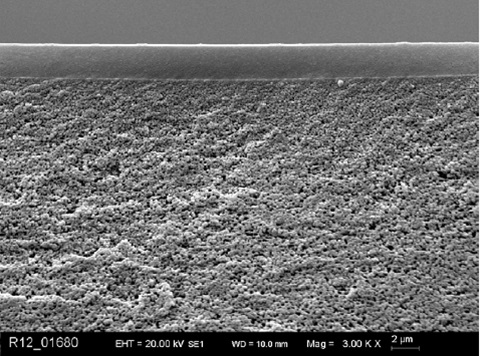
According to its producer and supplier, DeltaMem AG, its hydrophilic and hydrophobic pervaporation PERVAPTM membranes are the most extensively used pervaporation membranes worldwide. A modern development process has improved the separation performance and robustness of these membranes which are installed in industrial plants. Pervaporation (PV) and vapor permeation (VP) replace distillation and in some cases evaporation at improved economics. The operating costs from these conventional thermal separation processes are optimized because PV and VP have lower energy consumption; investment costs are also lowered.
Pervap membranes are housed in plate-frame modules and they are assembled into skids mounted units. It is possible to achieve novel and economic hybrid separation concepts (process intensification) by combining membranes with thermal and/or extractive separation technologies. The polymeric Pervap membrane is a pervaporation membrane. It is a proprietary composite membrane where the selective layer is a dense thin film based on polyvinyl alcohol (PVA) and silicon. The selective thin film layer is placed on an asymmetric porous membrane (with small pores at the top and bigger pores at the bottom) and a nonwoven fabric.
Challenges in development
After the first generation of Pervap membrane was developed and introduced into the market in1983, further research allowed the development of different membranes for different applications [1]. Although the membranes were successfully installed in industrial plants, there was still room to improve the separation performance of membranes for some applications.
In 2010, when the membrane manufacturing was relocated and modernized, the research & development team had the opportunity to work on improvements of the existing Pervap membranes. The main challenge of this work was to enhance the selectivity and robustness of membranes without affecting the flux, and thus, keep the membrane flux or improve it was a must.
Asymmetric porous structure
As the Pervap membranes have several layers, like a sandwich, the development of new membranes or improvement of the existing ones is a challenge because during the membrane fabrication there are several coating steps to fix the layers. One of the first step in the improvement of the membranes by researchers and engineers was to change the porous membrane support. The original polyacrylonitrile (PAN) porous support had a structure with finger-like holes. The new membrane support has an asymmetric porous structure without holes. This structure is consistent through the membrane. With the new porous support a good mass transport is always guaranteed due to the high porosity.
The membranes and their performance
As a second improvement, the membranes have multiple selective layers instead of a single layer. Thus, the membranes now are better in terms of both robustness and separation performance. According to DeltaMem, the multiple selective layers ensure a defect free membrane and enhance the membrane robustness; consequently the separation performance is enhanced. The flux of the former (black line) and the improved (blue line) membrane are similar, and the selectivity of the membrane has been improved. So far, six improved Pervap membranes have been brought to market. They are mainly used for the following applications: the dehydration of solvents, the separation of methanol from organic mixtures, and the removal of volatile organic compounds (VOCs) from water.
Positive market feedback
The improved Pervap membranes are installed in existing and new plants. Some plants have been using these membranes for more than two years. One customer states that the permeate quality is improved and it can be kept longer at given operating conditions. The DeltaMem research and development team continue to push the performance of membranes beyond what has currently been reached.
Conclusions
Through a complex optimization process, the existing pervaporation Pervap membranes have been steadily improved. On one hand, the porous support has been changed by one of asymmetric porous structure. This structure guarantees always the mass transport and hinders the compaction of porous support. On the other hand, the membrane has now multiple selective layers instead of single layer. So, the structure ensures a defect-free membrane and a selectivity enhancement. The membrane flux has not been altered.
Acknowledgements
DeltaMem AG, a management-buy-out (MBO) of Sulzer's membrane technology business, is a supplier to PV and VP plants worldwide. This article gratefully acknowledges the support of the research and development team from Sulzer Chemtech in Allschwil, Switzerland.
PERVAPTM is a registered trade mark.
References
[1] Please contact the author, Wilfredo Yave, Research and Development DeltaMem AG, for full references.



